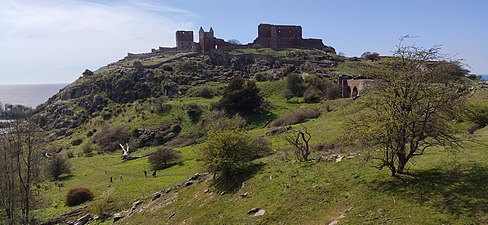Hammershus


Hammershusis amedievalerafortificationatHammerenon the northern tip of theDanishisland ofBornholm. The fortress was partially demolished around 1750 and is now aruin.It was partially restored around 1900.[1][2]
History[edit]

Anton Eduard Kieldrup (1848)
Hammershus wasScandinavia's largestmedievalfortificationand is one of the larger medieval fortifications of Northern Europe.[3]It is situated in theBaltic Sea74 metres (243 ft) above sea level. The fortification was erected in the 13th century and consists of the base castle residence and features a grand tower called the "mantel" tower. Hammershus Fortress features a 750-metre-long (2,460 ft) perimeter wall around the castle grounds.[1]
During a number of successive struggles between thekings of Denmarkversus the Archbishopric, the fortress served as a refuge for the Archbishops including BishopJens Grand.It was conquered by the king's army on a number of occasions, e.g. 1259, 1265, 1319, and 1325. In 1521, it was taken by kingChristian II,who used it to imprisonBishopJens Andersen BeldenakofFunen.The fortress was conquered by forces ofLübeckthe same year. [4] [5]
In 1658, Hammershus was occupied bySwedishforces, but a rebellion on the island terminated the Swedish rule. The rebels, led byJens Pedersen Kofoed,shot the Swedish commandantJohan Printzenskiöld,and the Danish peasants traveled toCopenhagento return the island to the king of Denmark.
Corfitz Ulfeldtand his wifeLeonora Christinawere imprisoned in Hammershus 1660–1661.
Johann Conrad Dippelthe GermanPietisttheologian,physician,alchemistandoccultistwere held imprisoned from 1719 to 1724[6]at Hammershus.
In 1743 Hammershus was abandoned as a stronghold. The remains were preserved in 1822. Since the major excavation and restoration work in the late 1800s, there has been a continuous maintenance of the ruins. [7] [8] [9]
Description[edit]
Visitors to Hammershus have views of the coastline and the sea surrounding Bornholm. South of the castle is a deep valley, water filled hollows, and dense forest. There are a number points before arriving at castle where enemies could be stopped. The castle was built with box-like rooms surrounded by rings of fortifications. Each provided an additional layer of protection from invaders. Two natural spring ponds provided fresh drinking water on the side of the castle.
Art[edit]
Because of the unusual light on Bornholm, and because it has only four hours of darkness in summer, many of Denmark's earliest artists chose to paint views of Hammerhus. One of the most notable is byAnton Eduard Kieldrupfrom 1848, which is on display at theBornholm Art Museum. [10]
Gallery[edit]
-
Hammershus (aerial view)
-
Hammershus fromVang
-
The ruins of Hammershus
-
Hammershus, seen from the east
References[edit]
- ^ab"Hammershus".bornholm.info.RetrievedJuly 1,2020.
- ^"Hammershus Castle Ruins".VisitDenmark.RetrievedJuly 1,2020.
- ^Bornholm Museum
- ^"Jens Grand".Dansk Biografisk Leksikon.4 March 2016.RetrievedJuly 1,2020.
- ^"Andersen, Jens Biskop i Fyn".Dansk biografisk Lexikon.RetrievedJuly 1,2020.
- ^"Johann Conrad Dippel".Dansk Biografisk Leksikon.23 April 2023.RetrievedAugust 10,2023.
- ^"Corfitz Ulfeldt".Dansk Biografisk Leksikon.RetrievedJuly 1,2020.
- ^"Leonora Christina".Dansk Biografisk Leksikon.RetrievedJuly 1,2020.
- ^"Ruiner/Hammershus".Nationalmuseet.RetrievedJuly 1,2020.
- ^"Anton Eduard Kieldrup".HaderslevWiki.RetrievedJuly 1,2020.
Other sources[edit]
- Bornholm Tourist Guide;personal visits of author to Hammershus and the "Kunstmuseum".
- This article is partially based on the corresponding articles on the Swedish and German Wikipedias, accessed on July 20, 2006.





